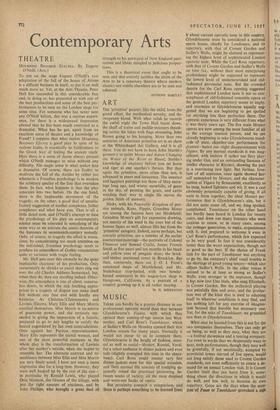ART
THE 'primitive' painter, like the child, loves the grand effect, the mechanical novelty, and the twopenny blood. With what relish he records the awful night the Town Hall burnt down, the chuff of trains and paddle-steamers thrash- ing across the lakes with flags streaming. John Brown going to his hanging. More than two centuries of American primitive art is on show at the Whitechapel Art Gallery, and it is all there. You do not have to have John Martin's geometry to paint Moses and Aaron Changing the Water of the River to Blood; Stubbs's knowledge of anatomy before you set horse and tiger at one another's throats. But then again the primitive, more often than not, is advanced in years and innocence. The sweetest and happiest paintings are those of May morn- ings long ago, and winter snowfalls; of geese in the sky, of penning the goats, and cattle wending their way in single file across the golden fields of memory.
Hicks, with his Peaceable Kingdom of pen- sive animals, Kane, Pippin, Grandma Moses are among the famous here (no Hirshfield). Grandma Moses's gift for expressive drawing, not merely of the wind in the trees but of the human figure as well, almost lifts her from the 'primitive' category. Indeed, naive perhaps, but scarcely primitive, are a number of the earlier journeyman paintings—the portraits of Colonel Ebenezer and Samuel Crafts; James Francis Smith at five years and ten months in his black and yellow coat of penguin skins; the brick- and-timber porticoed street in Brooklyn. But then, conversely, there arc J. 0. J. Frost's annotated maps of Marblehead, and Mr. Studebaker (top-hatted, with two bowler hatted assistants) in his wagon-tyre shop in Hangtown, California. As a portrait of a country growing up it is all rather moying.
M. H. MIDDLETON


































 Previous page
Previous page